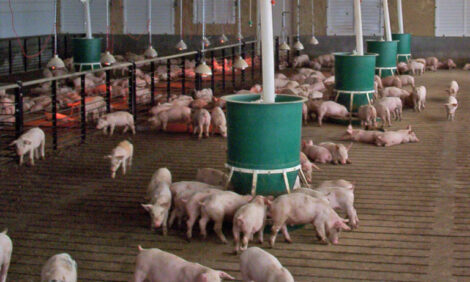



Efficacy of PRRS Virus Inactivated Vaccine Based on Viral Quantity & Inactivation Methods
Researchers in South Korea have assessed the efficacy of porcine reproductive respiratory syndrome (PRRS) virus inactivated vaccine based on the viral quantity and inactivation methods in order to control the virus, which appears to have infected pig herds across the country, based on antibody testing.There have been many efforts to develop efficient vaccines to control of porcine reproductive and respiratory syndrome virus (PRRSV), say Hyunil Kim (Optifarm Solution Inc. and Seoul National University) and co-authors there and at Green Cross Veterinary Products and the Korea Research Institute of Bioscience and Biotechnology in Daejon. They have recently published a paper on the efficacy of PRRS virus-inactivated vaccine based on virus quantity and inactivation methods in Virology Journal.
Kim and co-authors explain that although inactivated PRRSV vaccines are preferred for their safety, they are weak at inducing humoral immune responses and controlling field PRRSV infection, especially when heterologous viruses are involved.
In all groups in their experiment, the sample to positive (S/P) ratio of IDEXX ELISA and the virus neutralisation (VN) titre remained negative until challenge.
While viraemia did not reduce in the vaccinated groups, the IDEXX-ELISA-specific immunoglobulin G increased more rapidly and to significantly greater levels seven days after the challenge in all the vaccinated groups compared to the non-vaccinated groups (p<0.05). VN titre was significantly different in the 106 PFU/mL PRRSV vaccine-inoculated and binary ethylenimine (BEI)-inactivated groups 22 days after challenge (p<0.05). Consequently, the inactivated vaccines tested in this study provided weak memory responses with sequential challenge without any obvious active immune responses in the vaccinated pigs.
The researchers concluded that the inactivated vaccine failed to show the humoral immunity but it showed a different immune response after the challenge compared to mock group. Although the 106 PFU/mL-vaccinated and BEI-inactivated groups showed significantly greater VN titres 22 days after challenge, all the groups were already negative for viraemia. They added that the BEI-inactivated vaccine with a greater virus titre should be considered for testing to evaluate the efficacy of killed PRRSV vaccines.
Reference
Kim H., H.K. Kim, J.H. Jung, Y.J. Choi, J. Kim, C.G. Um, S.B. Hyun, S. Shin, B. Lee, G. Jang, B.K. Kang, H.J. Moon and D.S. Song. 2011. The assessment of efficacy of porcine reproductive respiratory syndrome virus inactivated vaccine based on the viral quantity and inactivation methods. Virology Journal, 8:323 doi:10.1186/1743-422X-8-323
Further Reading
| - | You can view the full report by clicking here. |
Further Reading
| |
- | Find out more information on porcine reproductive respiratory syndrome (PRRS) by clicking here. |
August 2011








